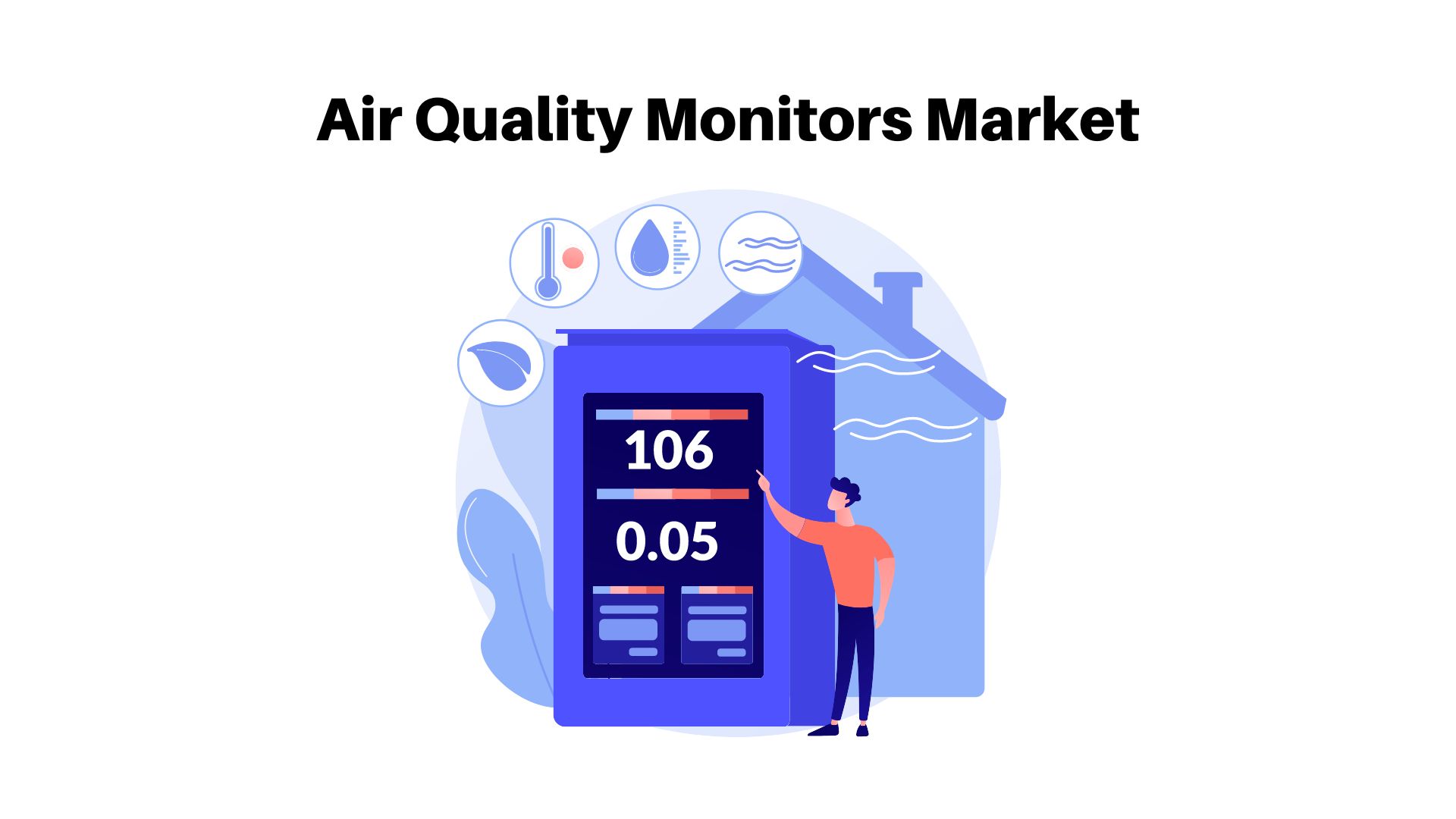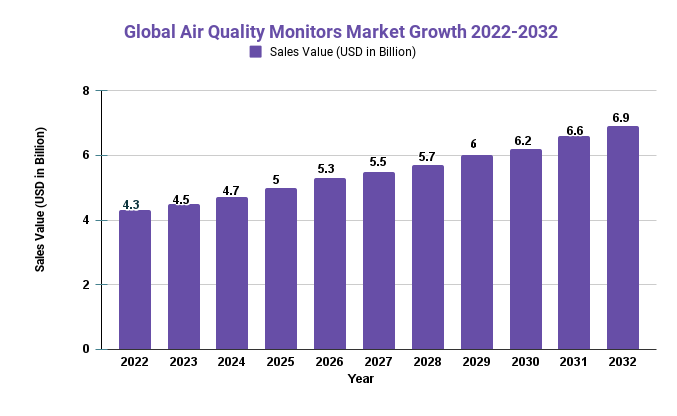Air Quality Monitors Market was valued at nearly USD 6.9 billion by 2032

Page Contents
Market Overview
Published Via 11Press: The Air Quality Monitors Market size is expected to be worth around USD 6.9 Bn by 2032 from USD 4.3 Bn in 2022, growing at a CAGR of 5.1% during the forecast period from 2022 to 2032.
The air quality monitors market is rapidly growing as awareness about the impact of air pollution on human health and the environment increases. Air quality monitoring devices are used to measure and monitor various pollutants such as particulate matter, volatile organic compounds (VOCs), and carbon monoxide in the atmosphere. These devices play a crucial role in providing real-time information about air quality, enabling individuals and organizations to take necessary measures to mitigate the negative impacts of air pollution.
Factors such as increasing urbanization, industrialization, and population growth have led to a rise in demand for air quality monitors across various sectors such as residential, commercial, industrial, and healthcare. The adoption of smart technologies has further propelled market growth by introducing innovative features such as remote monitoring through mobile applications or cloud-based platforms. Additionally, government initiatives aimed at reducing air pollution levels have boosted the demand for these devices globally.
Request For Sample Report Here: https://market.us/report/air-quality-monitors-market/request-sample/

Key Takeaways
- Increasing awareness about the harmful effects of air pollution on health and the environment is driving the demand for air quality monitors.
- The market is segmented by product type into indoor and outdoor air quality monitors, with indoor air quality monitors holding a larger market share due to their growing adoption in residential and commercial settings.
- The use of smart technology, such as the Internet of Things (IoT) and Artificial Intelligence (AI), in air quality monitors is gaining traction, as it allows for real-time data monitoring and analysis.
- North America and Europe are currently the largest markets for air quality monitors due to strict regulations on air pollution and high levels of industrialization. However, Asia Pacific is expected to witness significant growth in the coming years due to rising urbanization and increasing government initiatives for environmental protection.
- Key players in the air quality monitors market include 3M, Aeroqual, Thermo Fisher Scientific, Camfil, Carrier, Cerex Monitoring Solutions, Clarcor (Acquired by Parker Hannifin), FloCore, Fluke, Honeywell International, Lennox International, PPM Technology and TSI
Regional Analysis
- North America is currently the leading market for air quality monitors due to stringent regulations on pollution and high levels of industrialization in the region. The United States accounts for most of this growth within North American markets.
- Europe is the second-largest market for air quality monitors, with countries such as Germany, France, and the United Kingdom leading the charge. Due to strict regulations on air pollution in these regions, many consumers have begun adopting air quality monitors.
- The Asia Pacific region is expected to experience significant growth in the air quality monitors market due to rising urbanization, government initiatives for environmental protection, and raising awareness about air pollution's harmful effects on health. China, India, and Japan are some of the key contributors to this region.
- The Latin America region is expected to experience growth in the air quality monitors market due to an increasing government focus on environmental protection and growing awareness about air pollution's detrimental effects on health. Brazil and Mexico are leading contributors to this region's market share.
- The Middle East and Africa region is expected to experience moderate growth in the air quality monitors market due to increased government focus on environmental protection and increasing awareness about air pollution's detrimental effects on health. South Africa and the United Arab Emirates are two key contributors to this region.
Drivers
Increasing awareness about the harmful effects of air pollution on health and the environment, The growing awareness among people about the negative impacts of air pollution on health and the environment is driving the demand for air quality monitors. Stringent government regulations and policies, Governments across the globe are imposing strict regulations and policies to control air pollution, which is leading to the widespread adoption of air quality monitors in both indoor and outdoor settings.
Technological advancements, The use of advanced technologies such as the Internet of Things (IoT) and Artificial Intelligence (AI) in air quality monitors are gaining traction as it allows for real-time monitoring and analysis of air quality data, enabling proactive measures to be taken. Increasing industrialization and urbanization, Rapid industrialization and urbanization are leading to a significant increase in air pollution, driving the demand for air quality monitors in residential, commercial, and industrial settings.
Growing demand for indoor air quality monitors, With the majority of people spending more time indoors, the demand for indoor air quality monitors is increasing to ensure that the air quality inside homes and workplaces is healthy and safe. Increasing adoption of smart homes and smart buildings, The increasing adoption of smart homes and smart buildings is driving the demand for air quality monitors as they enable homeowners and facility managers to monitor and manage indoor air quality in real time.
Restraints
Funding Issues for Air Quality Monitoring Programs, Governments, and organizations may not allocate enough funding for air quality monitoring initiatives, limiting the resources available to invest in quality monitors. Slow Adoption in Some Regions, While some regions, are seeing rapid adoption of air quality monitors, others may take longer to adopt due to a lack of awareness, limited resources, or other obstacles. Limited Regulation in Certain Regions, Some regions may lack comprehensive regulatory frameworks for air quality monitoring, which could limit the incentives for individuals and organizations to invest in these systems.
Difficulty Accessing Certain Areas Remote or heavily industrialized regions may pose difficulties for air quality monitoring purposes, limiting their effectiveness as sites for monitoring. Dependence on External Factors, Air quality monitors can be affected by external elements like weather conditions, making it difficult to guarantee that the data collected is accurate and dependable. Maintenance and Calibration Requirements, Air quality monitors require routine maintenance and calibration in order to guarantee accurate data collection. However, the cost and effort associated with upkeep may prove prohibitive for some organizations and individuals.
Opportunities
Integration with Smart Cities, Integrating air quality monitors into smart city infrastructure can provide real-time data on air quality, which city planners can use to take proactive measures to reduce air pollution. Expansion of the Market in Developing Countries, As developing countries, experience rapid industrialization and urbanization, leading to an increase in air pollution levels, there is a significant growth potential for the air quality monitors market in these nations.
Development of Portable Air Quality Monitors, There is an increasing need for portable air quality monitors that individuals can take with them to monitor the air quality around them. The development of such devices could present a new growth opportunity to the market. Collaboration with Healthcare Industry, Air pollution has a serious effect on health, and there is growing interest in using air quality data to monitor and manage respiratory diseases. Collaborating with the healthcare sector could open new prospects for those in the air quality monitors market. Adoption of air quality monitors in vehicles, Installing air quality monitors in vehicles can provide real-time data on air quality while traveling, which could be especially helpful for individuals with respiratory diseases or those living in areas with high levels of air pollution.
Ensure everything is in line with your specific requirements here: https://market.us/report/air-quality-monitors-market/#inquiry
Challenges
High-Cost Air quality monitors can be expensive, particularly for advanced models that utilize smart technology like IoT and AI. This may pose a significant barrier to adoption for individuals or organizations with limited budgets. Limited Accuracy of Some Devices, Some air quality monitors may not provide precise data due to limitations in their sensors or calibration, which could reduce trust in the results and limit how effective these devices are at mitigating pollution.
Lack of Standardization Air quality monitoring lacks standardization, leading to confusion among consumers and limited data comparison across different devices and regions. Limited Awareness among Consumers Despite growing awareness about air pollution's harmful effects, many consumers may still not be aware of the advantages of air quality monitors and how they can protect both their health and the environment. Technical Challenges Integrating cutting-edge technologies like IoT and AI can present technical difficulties, such as reliable connectivity and data processing capabilities. This may limit some devices' usefulness in real-world settings. Limited Access to Power Sources, Some air quality monitors require a constant power source, which may prevent their use in remote or outdoor locations where power may be scarce.
Report Scope
| Report Attribute | Details |
| The market size value in 2022 | USD 4.3 Bn |
| Revenue forecast by 2032 | USD 6.9 Bn |
| Growth Rate | CAGR Of 5.1% |
| Regions Covered | North America, Europe, Asia Pacific, Latin America, and Middle East & Africa, and the Rest of the World |
| Historical Years | 2017-2022 |
| Base Year | 2022 |
| Estimated Year | 2023 |
| Short-Term Projection Year | 2028 |
| Long-Term Projected Year | 2032 |
Key Market Segments
Type
- Indoor Air Quality Monitors
- Outdoor Air Quality Monitors
Application
- Government
- Commercial and Residential
- Energy and Pharmaceutical
Key Market Players
- 3M
- Aeroqual
- Thermo Fisher Scientific
- Camfil
- Carrier
- Cerex Monitoring Solutions
- Clarcor (Acquired by Parker Hannifin)
- FloCore
- Fluke
- Honeywell International
- Lennox International
- PPM Technology
- TSI
Frequently Asked Questions
What is the market study period?
The Air Quality Monitors Market is studied from 2017 – 2032.
What is the growth rate for the Air Quality Monitors Market?
The Air Quality Monitors Market is growing at a CAGR of 5.1%
Which region experiences the highest rate of growth in the Air Quality Monitors Market?
Asia Pacific is growing at the highest CAGR over 2022- 2032.
Which region is the largest in the Air Quality Monitors Market?
North America holds the highest share in 2022.
Who are the major players in the Air Quality Monitors Market?
3M, Aeroqual, Thermo Fisher Scientific, Camfil, Carrier, Cerex Monitoring Solutions, Clarcor (Acquired by Parker Hannifin), FloCore, Fluke, Honeywell International, Lennox International, PPM Technology, TSI
The team behind market.us, marketresearch.biz, market.biz and more. Our purpose is to keep our customers ahead of the game with regard to the markets. They may fluctuate up or down, but we will help you to stay ahead of the curve in these market fluctuations. Our consistent growth and ability to deliver in-depth analyses and market insight has engaged genuine market players. They have faith in us to offer the data and information they require to make balanced and decisive marketing decisions.